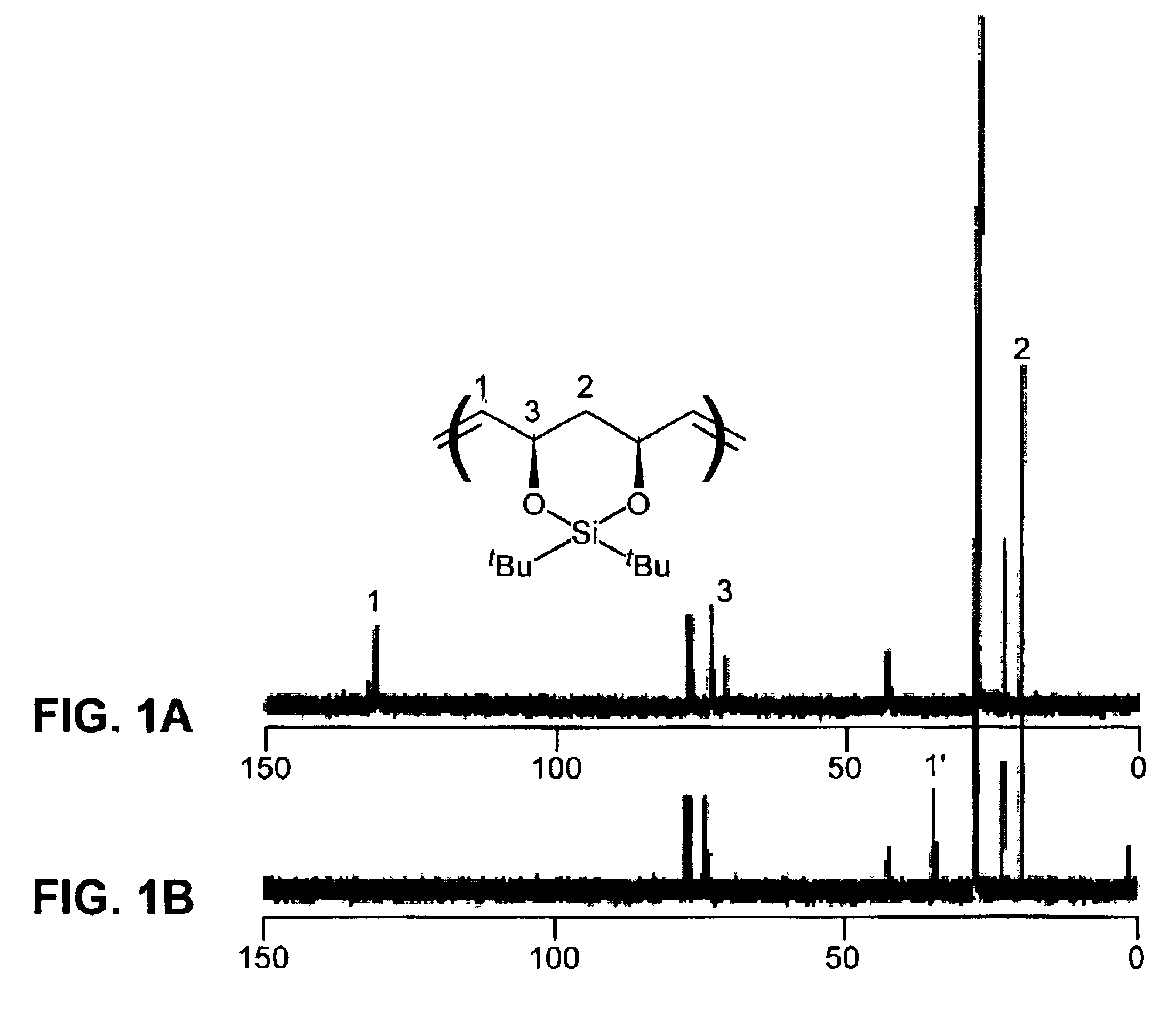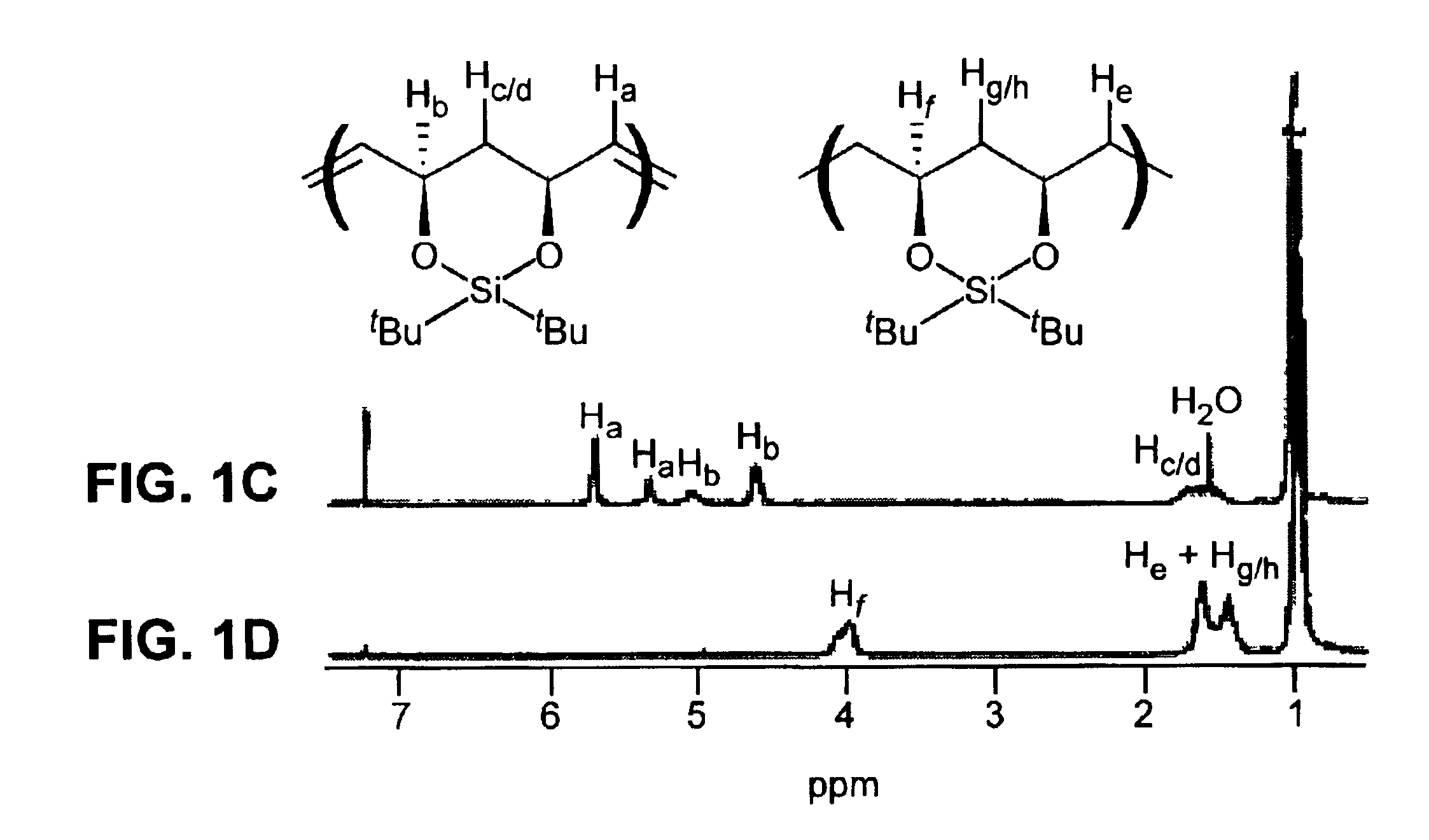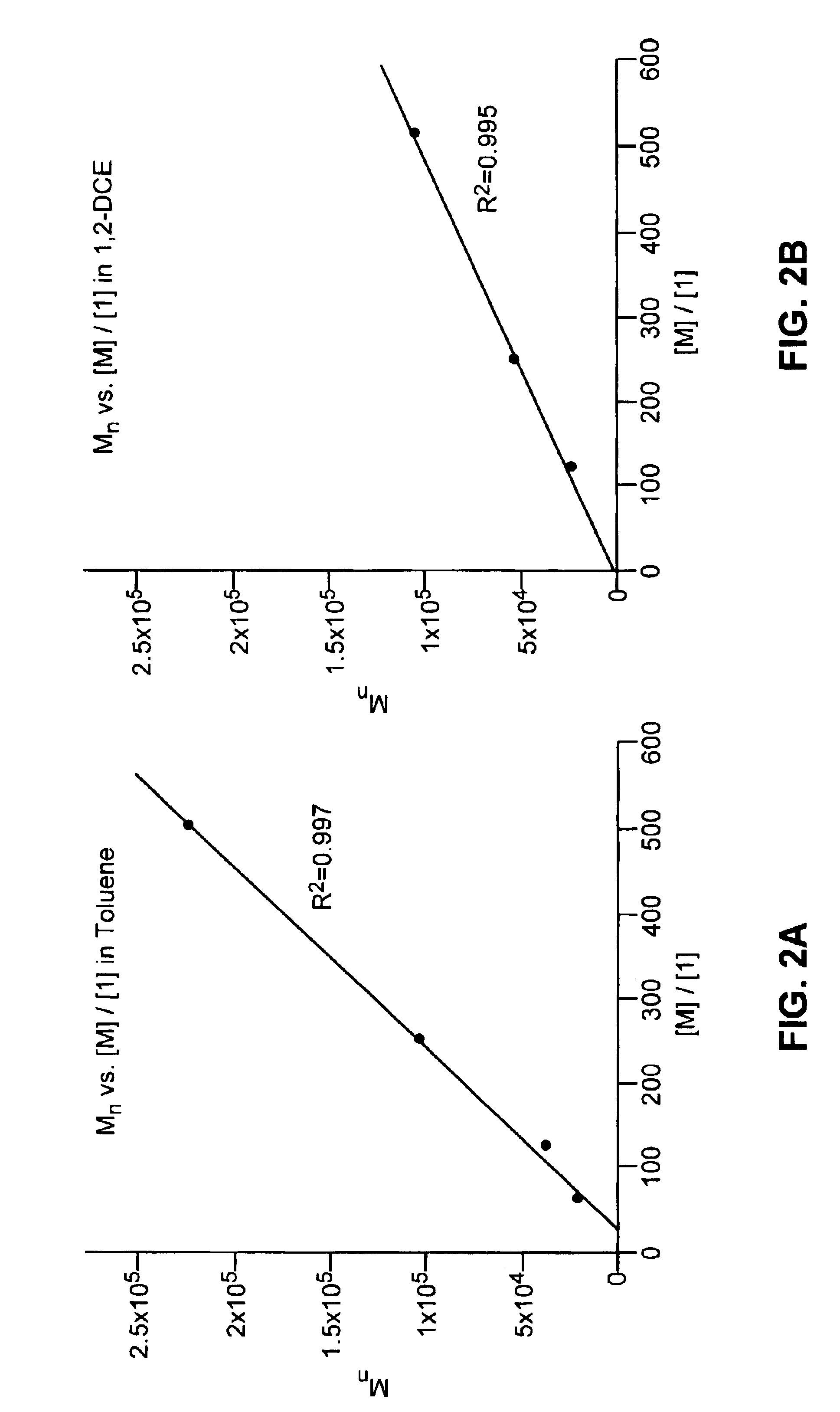Ring-opening metathesis polymerization of bridged bicyclic and polycyclic olefins containing two or more heteroatoms
a polymerization and polymerization technology, applied in the field of polymer synthesis, can solve the problems of limiting the barrier properties of the final evoh copolymer, and neither the more active (2) nor the catalyst (1) could afford the romp of these cyclopentene monomers, so as to limit the utility of the polymer prepared
- Summary
- Abstract
- Description
- Claims
- Application Information
AI Technical Summary
Benefits of technology
Problems solved by technology
Method used
Image
Examples
example 1
Polymerization of 3,3-di-tert-butyl-2,4-dioxa-3-silabicyclo[3.2.1]oct-6-ene (3) via ROMP with Catalyst (1)
[0140]
[0141]Representative procedure for synthesis of a protected, unsaturated, regioregular polymer (Scheme 2): A small vial was charged with 0.25 g (1.0 mmol) of monomer (3) and a stirbar. The monomer was degassed by three freeze-pump-thaw cycles. 3.4 mg (4.13×10−6 mol) of catalyst (1) was added as a solution in 1,2-dichloroethane or toluene (1 mL of solvent). The vial was placed in a 55° C. aluminum heating block, stirring under argon for approximately 20 h. The reaction mixture was dissolved in 3 mL of dichloromethane and precipitated into 50 mL of stirring methanol. The white polymer precipitate was washed several times with methanol and dried in vacuo overnight; yield of polymer (4), 77-95%. 1H NMR (300 MHz, CDCl3): 5.75 trans (bs, 2H), 5.38 cis (d, J=4.0 Hz, 2H), 5.08 cis (d, J=8.8 Hz, 2H), 4.62 trans (d, J=10.2 Hz, 2H), 1.4-1.8 (m, 2H), 1.0 (18H). 13C NMR (75 MHz, CDCl3)...
example 2
Polymerization of 3,3-di-tert-butyl-2,4-dioxa-3-silabicyclo[3.2.1]oct-6-ene (3) via ROMP with Catalyst (2) and CTA (5)
[0144]
[0145]Representative procedure for synthesis of an unsaturated, protected, telechelic polymer (Scheme 3): A small vial was charged with 0.25 g (1.0 mmol) of monomer (3) and a stirbar. The monomer was degassed by three freeze-pump-thaw cycles. Under an argon atmosphere, 0.25 mL (1.0×10−2) mmol) of a 6.90 mg / mL solution of (5) (as a charge transfer agent, or “CTA”) in toluene solution was added via a syringe. Then 0.75 mL (5.3×10−5 mmol) of a 0.0595 mg / mL solution of (2) in toluene was added via a syringe. The vial was placed in a 55° C. heating apparatus and left stirring under argon for 23-113 h. The reaction mixture was dissolved in 2 mL of dichloromethane and precipitated into 50 mL of stirring methanol. The white polymer precipitate was washed several times with methanol and dried in vacuo overnight; yield of polymer (6) 82-90%. 1H NMR (300 MHz, CDCl3): 5.73...
example 3
Hydrogenation of Polymers after ROMP
[0149]
[0150]Representative procedure for hydrogenation of protected unsaturated polymers (Scheme 4): A dry flask was charged with 0.35 g of polymer (4), prepared in Example 1 (Mn=80,360, PDI=1.3), 1.80 g of tosyl hydrazide (9.4 mmol, 6.5 equiv per double bond), 15 mL of xylenes, and a trace of BHT. The mixture was degassed by three freeze-pump-thaw cycles, and a reflux condenser was attached to the flask under argon. The reaction was heated to reflux for 4 h. The solution was cooled to room temperature and then precipitated into 125 mL of stirring methanol. The white polymer precipitate was washed several times with methanol and then dried in vacuo overnight; yield of polymer (7) was 0.34 g (99%). Mn=75,140 g / mol, PDI=1.2, dn / dc=0.076. 1H NMR (300 MHz, CDCl3): 3.9-4.1 (2H), 1.4-1.7 (6H), 1.0 (18H). 13C NMR (75 MHz, CDCl3): 74.1, 73.5, 73.4, 42.4, 42.3, 34.8, 34.3, 27.8, 27.7, 27.3, 22.8, 19.7.
[0151]FIG. 1A displays the 13C NMR spectrum of the unsa...
PUM
| Property | Measurement | Unit |
|---|---|---|
| Fraction | aaaaa | aaaaa |
| Fraction | aaaaa | aaaaa |
| Fraction | aaaaa | aaaaa |
Abstract
Description
Claims
Application Information
 Login to View More
Login to View More - R&D
- Intellectual Property
- Life Sciences
- Materials
- Tech Scout
- Unparalleled Data Quality
- Higher Quality Content
- 60% Fewer Hallucinations
Browse by: Latest US Patents, China's latest patents, Technical Efficacy Thesaurus, Application Domain, Technology Topic, Popular Technical Reports.
© 2025 PatSnap. All rights reserved.Legal|Privacy policy|Modern Slavery Act Transparency Statement|Sitemap|About US| Contact US: help@patsnap.com



